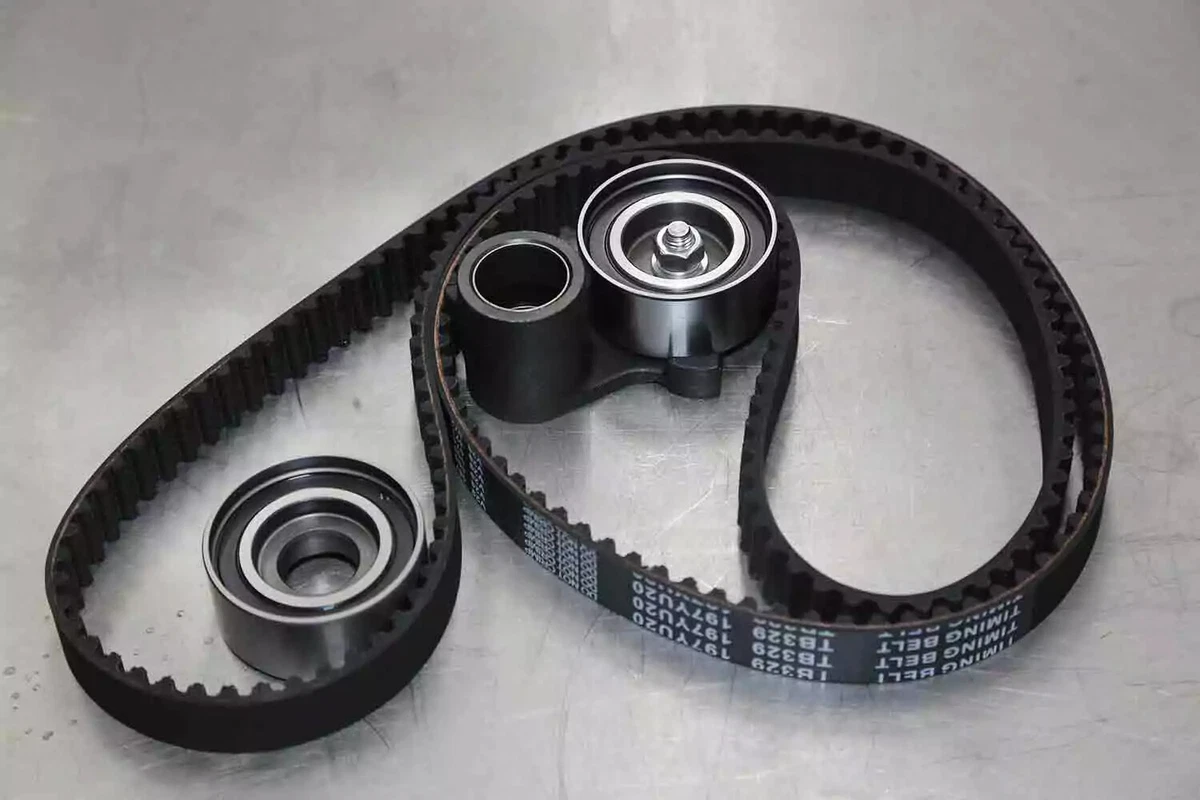Most timing belts should be replaced between 60,000 and 100,000 miles. Failing to change the belt on this schedule could create catastrophic engine problems.
The timing belt, which is typically rubber, connects the crank gear to the cam gears. The timing belt is the only thing keeping your engine’s cams in sync with the rotation of the crankshaft. Most timing belts are cogged, meaning they have rubber teeth that mesh with the gears.
Most modern engines are “interference engines.” If your timing belt slips even one tooth, the parts inside your engine can collide. In an instant, your engine goes kaput. Call a tow truck and prepare yourself for a full engine rebuild or replacement.
Timing belts are designed to be dry. This is why they are installed outside of the engine. A timing chain is internal. If the timing belt is exposed to oil from a front crank seal leak, then the belt could come apart. If your engine has an oil leak at the front of the engine, you should replace the timing belt at the same time as the front crank seal.
Size and Brand Are Important

Automotive timing belts are cogged to ensure the gears stay in time with each other.
Finding the right belt is easy with
eBay’s Parts Finder
- opens in new window or tab.
. Enter your details—year, make, model, engine, and trim—to filter for parts that fit your vehicle. Size is the critical factor. Timing belts are not interchangeable. You can’t make a slightly longer or shorter belt fit. It must be the exact same size as the original belt.
Automakers themselves sell their own timing belts, which are referred to as original equipment manufacturer (OEM) belts. While an OEM belt is the standard, you may end up paying an unnecessary premium for the name and not the quality of the belt.
Original equipment brands—such as Dayco, Gates, Goodyear, and SKF—make excellent belts for the OEM. You can rest assured the replacement belt is durable and made to fit.
Buy a Timing Belt Kit

A typical non-water-pump timing belt kit includes the belt, a new idler pulley, and a tensioner.
In many cases, the timing belt is not just for the cam gears. The timing belt often drives the water pump as well. These engines require you to change the water pump when you replace the belt. Buying a kit provides all the parts to get everything done.
You pay a little more for the kit, but it’s cheaper than buying the parts separately. Timing belt kits also come with the necessary pulleys and tensioners to keep the belt tight and running smoothly.
Other Parts to Consider Changing

This is a timing belt-driven water pump. The pulley may be cogged or smooth, depending on the engine.
In most cases, you have to remove the water pump to get to the timing belt. If the belt does not drive the water pump, you can reinstall the old one. Even then, this is a great time to change it.
Other items to consider changing along with the timing belt include the coolant thermostat, upper and lower radiator hoses, and the serpentine belt with tensioner and idler pulley. It might sound like a lot, but timing belt replacement is a big job. These are small and efficient items to add.
Tools Needed to Replace Your Timing Belt

Some engines, like this Honda V-6, require special crank bolt tools. This large socket holds the crank from spinning while the impact gun removes the crank bolt.
Most vehicles require a crank balancer removal tool to draw the crank pulley off the crankshaft. Some engines, such as Honda and Toyota, need a special crank lockout tool to remove the crank bolt. Many modern engines have switched to torque-to-yield (TTY) crank bolts, which are not reusable. Check your vehicle’s repair manual for details on the correct fasteners. You might have to order them, as well.
You also need a torque wrench, breaker bar, and various sockets and wrenches to get this job done on most vehicles. If you drive an economy car or family car with front- or all-wheel-drive, your engine is likely mounted horizontally. For these cars, the belts face the inner fenders. So you need long wrenches and to remove suspension components to reach the fasteners on the engine. Longitudinally-mounted engines, commonly used in pickup trucks and vintage cars, are easier to work on. You can remove the radiator to gain more space.
Changing a timing belt is an advanced skill level DIY project, primarily due to the cramped nature of where everything is positioned. Expect to spend about two to five hours on this project.
Share your feedback
This article is meant to provide general guidance only. Automotive maintenance, repair, upgrade, and installation may depend on vehicle-specifics such as make and model. Always consult your owner's manual, repair guide for specific information for your particular vehicle and consider a licensed auto-care professional's help as well, particularly for advance repairs.




























































